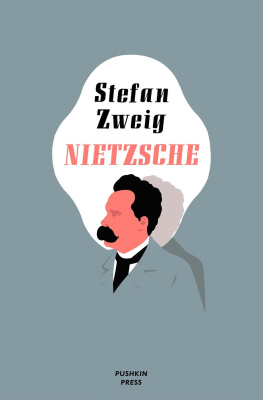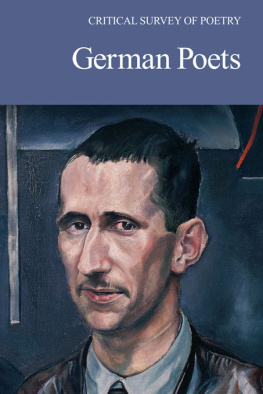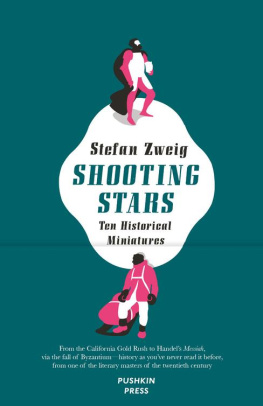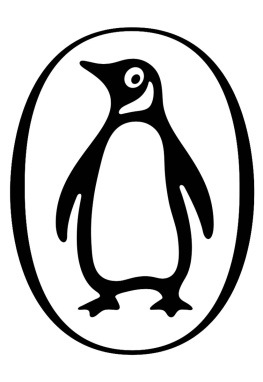George Stefan - The look of things: poetry and vision around 1900
Here you can read online George Stefan - The look of things: poetry and vision around 1900 full text of the book (entire story) in english for free. Download pdf and epub, get meaning, cover and reviews about this ebook. City: Chapel Hill, year: 2003, publisher: The University of North Carolina Press, genre: Romance novel. Description of the work, (preface) as well as reviews are available. Best literature library LitArk.com created for fans of good reading and offers a wide selection of genres:
Romance novel
Science fiction
Adventure
Detective
Science
History
Home and family
Prose
Art
Politics
Computer
Non-fiction
Religion
Business
Children
Humor
Choose a favorite category and find really read worthwhile books. Enjoy immersion in the world of imagination, feel the emotions of the characters or learn something new for yourself, make an fascinating discovery.

- Book:The look of things: poetry and vision around 1900
- Author:
- Publisher:The University of North Carolina Press
- Genre:
- Year:2003
- City:Chapel Hill
- Rating:4 / 5
- Favourites:Add to favourites
- Your mark:
- 80
- 1
- 2
- 3
- 4
- 5
The look of things: poetry and vision around 1900: summary, description and annotation
We offer to read an annotation, description, summary or preface (depends on what the author of the book "The look of things: poetry and vision around 1900" wrote himself). If you haven't found the necessary information about the book — write in the comments, we will try to find it.
The look of things: poetry and vision around 1900 — read online for free the complete book (whole text) full work
Below is the text of the book, divided by pages. System saving the place of the last page read, allows you to conveniently read the book "The look of things: poetry and vision around 1900" online for free, without having to search again every time where you left off. Put a bookmark, and you can go to the page where you finished reading at any time.
Font size:
Interval:
Bookmark:
THE LOOK OF THINGS
UNIVERSITY OF NORTH CAROLINA
STUDIES IN THE GERMANIC LANGUAGES
AND LITERATURES
Initiated by RICHARD JENTE (19491952),
established by F. E. COENEN (19521968),
continued by SIEGFRIED MEWS (19681980),
RICHARD H. LAWSON (19801985), and
PAUL T. ROBERGE (19852000)
JONATHAN M. HESS, Editor
Publication Committee: Department of Germanic Languages
122 JANE O. NEWMAN. The Intervention of Philology: Gender, Learning, and Power in Lohensteins Roman Plays. 2000. Pp. xviii, 228.
123 JAMES F. POAG AND CLAIRE BALDWIN, EDS. The Construction of Textual Authority in German Literature of the Medieval and Early Modern Periods. 2001. Pp. xiv, 290.
124 WILLIAM COLLINS DONAHUE. The End of Modernism: Elias Canettis Auto-da-F. 2001. Pp. xviii, 283.
125 GERHARD RICHTER, ED. Literary Paternity, Literary Friendship: Essays in Honor of Stanley Corngold. 2002. Pp. xii, 415.
126 CARSTEN STRATHAUSEN. The Look of Things: Poetry and Vision around 1900. 2003. Pp. xiv, 325.
Send orders to:
The University of North Carolina Press
Post Office Box 2288, Chapel Hill, NC 27515-2288
For other volumes in the Studies see pages 32325.
Number One Hundred and Twenty-Six
UNIVERSITY OF NORTH CAROLINA
STUDIES IN THE GERMANIC LANGUAGES
AND LITERATURES
2003
The University of North Carolina Press
All rights reserved
Manufactured in the United States
of America
The paper in this book meets the guidelines for permanence and durability of the Committee on Production Guidelines for Book Longevity of the Council on Library Resources.
Library of Congress
Cataloging-in-Publication Data
Strathausen, Carsten.
The look of things : poetry and vision around 1900 / by Carsten Strathausen.
p. cm. (University of North Carolina studies in the Germanic languages and literatures ; no. 126)
Includes bibliographical references and index.
ISBN 0-8078-8126-0 (alk. paper)
1. German poetry20th centuryHistory and criticism. 2. German poetry19th centuryHistory and criticism. 3. Rilke, Rainer Maria, 18751926Criticism and interpretation. 4. Hofmannsthal, Hugo von, 18741929Criticism and interpretation. 5. George, Stefan Anton, 18681933Criticism and interpretation. 6. Aestheticism (Literature) I. Title.
II. Series.
PT551.S77 2003
831'.91209dc21
2002152317
07 06 05 04 03 5 4 3 2 1
To Valerie and Clara
1. Title page of the first edition of Der Teppich des Lebens by Stefan George, 1900
2. Editorial commentary on the first edition of Der Teppich des Lebens by Stefan George, 1900
3. Two poems from the first edition of Der Teppich des Lebens by Stefan George, 1900
4. Photo of the train accident at the Gare Montparnasse in Paris in October 1895
5. Auguste Rodin, The Gates of Hell, 18801917
6. Auguste Rodin, The Gates of Hell, 18801917, detail
7. Paul Czanne, Still Life with Curta in and Flowered Pitcher, ca. 1899
8. Table of contents of the first publication of the Bltter fr die Kunst, October 1892
9. Photograph of Stefan George by Theodor Hilsdorf, ca. 1928
I am indebted to many of my colleagues and friends who have supported me during the many years that I worked on this project. First and foremost, many thanks to Roger Cook for his congenial support throughout my junior years at the University of Missouri as well as for his good humor and endless patience when working with me on early drafts of this book. Peter Gilgen, Noah Heringman, Brad Prager, and Nancy West all provided detailed and extremely helpful commentaries on single chapters of the manuscript. Bill Kerwin, Karen Piper, and Jeff Williams always gave me good advice and kept my spirits up during the final stages of the project, as did the entire crowd at Tellers (you know who you are!). Ulrich Baer and Neil H. Donahue offered valuable suggestions for revision of the final manuscript. This book would never have seen the light of day without the tireless efforts of Jonathan Hess, series editor for the University of North Carolina Studies in the Germanic Languages and Literatures, who always found the time to answer my questions and helped me along at every stage of the publication process. Adam Gori did an excellent job copyediting the final version of the manuscript, correcting numerous stylistic and syntactical errors. Many thanks also to the various institutions that granted me permission to reprint photos and illustrations, in particular to Ute Oelmann from the Stefan George-Archiv in Stuttgart. Both the University of Missouri Research Board and the Research Council provided financial support for this project. Finally, I want to express my gratitude to Kenneth S. Calhoon. The most inspiring thinker I have known, Ken guided me through my dissertation years at the University of Oregon and helped me to get on track for an academic job. This book is dedicated to my wife, Valerie Kaussen, and our daughter, Clara, with all my love.
THE LOOK OF THINGS
Epistemology is true as long as it recognizes the inadequacy of its own approach and lets itself be propelled forward by the impossibility of the task itself. It becomes untrue by pretending it is successful.
Adorno, Zur Metakritik der Erkenntnistheorie 33
This study examines the relationship between poetry, philosophy, and the visual media around 1900. More specifically, it focuses on questions of aesthetic mediation in the poetic works of Hugo von Hofmannsthal, Rainer Maria Rilke, and Stefan George. The question of mediation, of course, is central not only to German Aestheticist poetry, but also to literary scholarship and philosophical inquiries in general, which, as Jean-Franois Lyotard has recently argued, is characterized by its condemnation of all possible answers in favor of ever new and unanswerable questions. If a question can be answered, Lyotard caricatures the philosophical position, it was either not adequately formulated or merely a technical question, meaning that it should not have been asked at all.
Unlike Lyotard, I am inclined to take the issue more seriously. Since the investigation into the essence of things and the concomitant notion of absolute truth is, by definition, located beyond the dichotomy of question and answer, it follows that a true question cannot be answered, or, put differently: its answer would be superfluous, because it would already be inherent within the question itself. [I]n philosophy, Theodor W. Adorno remarks, any authentic question almost always in a certain way includes its answer (Sondern in Philosophie schliet stets fast die authentische Frage in gewisser Weise ihre Antwort ein) (Negative Dialektik 71).
To a certain degree, Benjamin accepts the epistemological dilemma constitutive of philosophical thought, whose eternal quest for primordial meaning cannot succeed lest it were to lose its reason for being, and thus, paradoxically, its proper meaning. An answer found signifies truth lost, which is why Lyotards mockery of the entire philosophical tradition sells the real issue short. At stake is less the paradoxical (or tautological) nature of human thought, but the question of how to come to terms with it. This problem of presentation (Darstellung) is crucial to the history of philosophy, and both its formulation and its aesthetic solution take on a peculiar shape in modernist poetry around 1900. The Look of Things focuses on precisely this shape in works by Hofmannsthal, Rilke, and George. I realize, of course, that my topic may seem questionable to those readers for whom the poetic search for truth and beauty epitomizes the very ideological perils of bourgeois Aestheticism. Why, indeed, should contemporary scholarship be interested in what traditionally has been dismissed as a decadent and conservative, if not openly reactionary, aesthetic paradigm?
Next pageFont size:
Interval:
Bookmark:
Similar books «The look of things: poetry and vision around 1900»
Look at similar books to The look of things: poetry and vision around 1900. We have selected literature similar in name and meaning in the hope of providing readers with more options to find new, interesting, not yet read works.
Discussion, reviews of the book The look of things: poetry and vision around 1900 and just readers' own opinions. Leave your comments, write what you think about the work, its meaning or the main characters. Specify what exactly you liked and what you didn't like, and why you think so.








